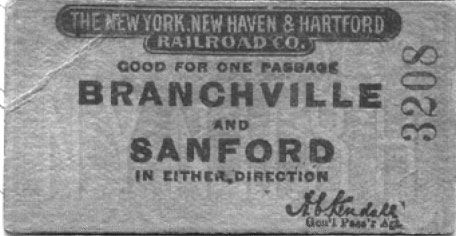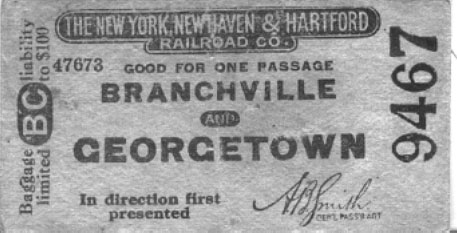|
Included
in this Georgetown Railroad History section is information
I have gathered from Gilbert & Bennett publications and
Wilbur F. Thompson articles. More information will be added
as I find it.
Please
let me know if there are more areas you'd like me to explore
or if you have further information. Contact bcolley@snet.net
or phone me at 860-364-7475.
The
History of the Railroad in Georgetown
In
the 1800's the demand for a better means of transportation
began to make itself felt. In 1825 a survey was made for a
canal from Danbury to tidewater at Westport. From Danbury,
through Bethel to the Saugatuck River in Redding, following
the course of the stream through Weston to tidewater. This
project was given up when it was found that Danbury was 350
feet above sea level.
In
1835 there were two surveys made for a railroad from Danbury
to Tidewater. One followed the old canal survey to West-port.
The other survey was along the line of the present D. & N.
R. R. In 1835 it was found that in 1834 over 8,000 tons of
freight was carried in freight wagons at $5 per ton, 10,000
passengers were carried by stage coaches to and from Danbury
for the fare of 75 cents and 1,000 passengers from Sections
between Danbury and Norwalk, for the fare of 50 cents.
The
first estimate was for a horse railway, be-tween the rails
there was to be a plank roadway or horse path. But nothing
was done until 1850, when the contract was let to Beard, Church
& Co. to build and equip a steam railroad. John Beard was
a resident of Danbury. These contractors sublet sections of
the work to other firms. The section between what is now Cannondale
and Topstone was known as the Georgetown section. The first
work done in this section was in the deep rock cut known as
"Couches Cut" between Branchville and Topstone. Cannon & Fields
was one of the firms contracted to do the grading of the Georgetown
section; Charles Cannon was from Wilton and Frank Fields was
from Croton Fall, N. Y. Mr. Fields had just finished a contract
on the Harlem R. R. and came well equipped to do the work.
The surveyors for the Georgetown section were Aaron B. Whitlock
of Croton Falls, N. Y., and Jcbediah I. Wanzer of Pawling,
N. Y. They were assisted by a young man, John W. Bacon, who
later became superintendent of the D. & N. R. R. They boarded
with Aaron Bennett, who lived an old house east of Connery's
coal yard in Georgetown. This boarding house stood north of
the Methodist Protestant Church know as Miller's Hall which
was later torn down.
The
following are names of some of the men employed to work on
the section:
Foreman,
Austin Walbridge, who later was engineer on the road for many
years;
Blacksmith,
Turney Stevens;
Bridgebuilders,
William Bedient, Steven Bedient, John Campbell;
Stone
Workers, William Avaunt, Waterman Bates, Alexander McDougal,
Harden Knapp. Knapp was foreman of the stone gang.
The
Norwalk section was finished first, and a train ran over that
section carrying rails and supplies as far as the road was
built. The engineer of this train was George Tucker. Work
on the railroad progressed and, on March 1, 1852, the first
train from Norwalk to Danbury went through. George Tucker
was engineer and Harvey Smith con-ductor. Above Redding Station
the ties and rails were all laid on frozen ground. The new
railroad was equipped with three engines, four first-class
and two second-class passenger cars, eight box and sixteen
platforms cars, and three hand cars. Two trains were run each
way daily after the railroad was completed.
The
first station agent in Georgetown was Silliman Godfrey, who
was also Postmaster. The next agent was Dr. Lloyd Seeley,
later Burr Bennett, and for many years James Corcoran. The
old Railway station which later burned down, was a two-story
building. In the first story was the Railway Station, Post
Office and store kept by Silliman Godfrey. On the second floor
was a large hall used for various purposes. In 1853 it was
the lodge room of Fraternal Division, No. 79, Sons of Temperance.
In the later 1850's, it was occupied by Fanton's shirt factory.
In 1862 it was the Armory of Co. E, 23rd Regiment, Connecticut
Volunteers, who were mustered into service in the Fall of
1862. Later it was used by the Gilbert & Bennett Co. for a
sieve shop.
Among
those employed in building the Georgetown section of the D.
& N. R. R. that settled in that vicinity were: William Avaunt,
Waterman Bates, John Bates, George Gould, Thomas Granville,
Richard Higgins, Patrick Maloney, Larry Fox, Alexander McDougal,
Thomas Pryor, John Rady, Billy Spain, George Tilly, Frank
Welch, Charles Vaughn, Michael Vaughn and others. Edson Smith
ran a stage coach from Ridgefield station (later Branchville
Station) to Ridgefield. Later he was for many years conductor
of the D. & N. Rail Road.

1908 Ticket
In
1874 The railroad was convinced by Gilbert and Bennett management
to run a spur line into the mill during reconstructive work
on the Norwalk-Danbury line, this paid huge dividends for
the future of the company. The track that came into the mill,
branched off from the railway just before the Georgetown Station
where Miller Hall stood, two team tracks split to the left,
one that lead to the back of Georgetown Station and one extending
further to the road. The main track split in two, joining
again in the factory. In addition to Miller's Hall, two small
sheds also stood, one was a coal shed. My Grandfather recalls
in the twenties and thirties, freight trains containing feed
and buildings supplies would be dropped off across from the
factory, once unloaded from the cars, feed would be taken
to the Gilbert/State farm and building supplies would be taken
to the Connery Brother's store.

1908 Ticket

1918 Ticket
Learn
more about the history of the
Danbury/Norwalk Railroad
Back
to TOP | Back to Redding
Section | Back to Georgetown
Section
|
|

